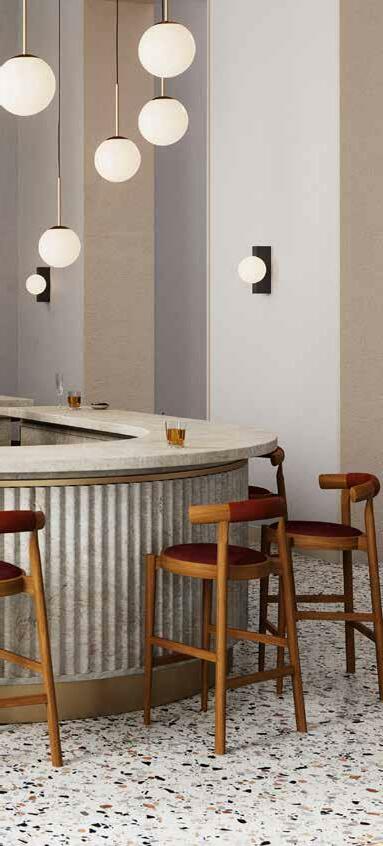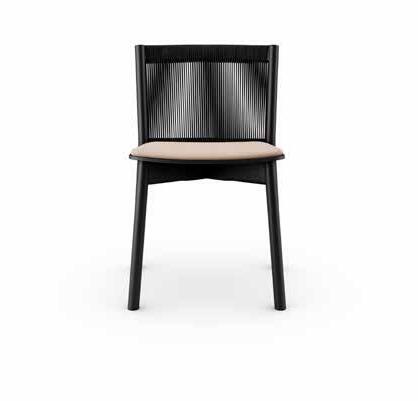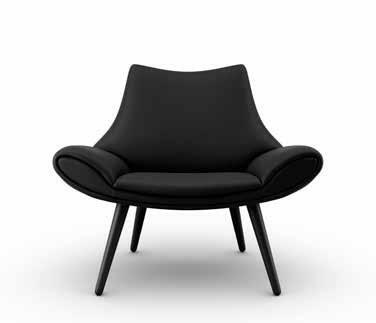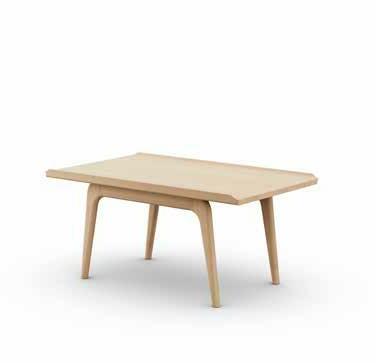




Our forward-looking furniture service is rooted in more than 110 years of experience.

Design has been a part of our DNA since 1908, when our parent company, Carl Hansen & Søn, started designing and crafting Danish design classics.
Studio CHS draws on this craftsmanship and knowledge, using expert artisans, the finest materials and inspired designers to create exceptional bespoke furniture for the hospitality industry.
And while our outlook is modern and forwardthinking, we still adhere to Carl Hansen & Søn‘s original vision: peerless design, remarkable quality, and a sustainable, ethical approach to working.
At Studio CHS, we are mindful of where we’ve come from. But we are always looking to the future.
We manage, own and control as much of the supply chain as possible to ensure the highest standards.
Quality is everything in the world of high-end handcrafted furniture. At Studio CHS, we operate a ‘vertically integrated’ business, where we have direct ownership of the entire production process, and full control of our output.

Our designs are brought to life together with our product development team in Denmark, which are expertly made into mock-ups and models in our workshop in Vietnam. The carefully chosen local artisans work in our wood processing facility, sawmill, and wood drying facility, as well as in-house carving, weaving and upholstery workshops.



Respect runs through our business, for our materials, the planet and each other.
In everything we do, we always try to make the right choices. Whether it is creating new jobs and training young talent, preserving crafting techniques, sourcing sustainable materials or making our resources go further through responsible production. In our business, we believe that honesty, integrity and clarity are non-negotiable.
At Studio CHS, we operate a zero-waste policy, repurposing left-over wood remnants to make accessories. Or if they are too small, we use them to heat the kilns in our sawmill and wood drying facilities.

Exclusively working with hospitality, restaurant and corporate industries, Studio CHS handcrafts exceptional pieces that come from over a century of experience, but are in line with today’s business needs.



A century of knowledge and a future of creativity.
By offering a ready-made collection and bespoke service, Studio CHS takes a century of knowledge and expertise in new directions, working with up-andcoming new designers and co-collaborating with luxury partners to convey their brand in new ways.


Our bespoke services redefine quality furniture at accessible prices.
Hand-crafting outstanding one-off pieces especially for the hospitality industry.

Our bespoke service allows you to become part of the creative process – and join us on the journey through design and execution. By co-collaborating with a designer on each piece, you have the freedom and flexibility to shape your vision, producing outstanding one-off pieces of hand-crafted furniture that reflect your business needs perfectly.







A ready-made furniture collection of iconic pieces inspires you to create your look or allows you to buy the highest-quality Danish design straight off the shelf. It’s part of our commitment to make brilliantly designed, high-quality furniture available to more people at an accessible price.


Bent Møller Jepsen is a Danish furniture designer. He started his career as an upholsterer and in his furniture design, quality upholstery is always the guiding principle. Jepsen has worked and taught in most parts of the world on production, materials, quality, and design.
Andreas Kowalewski is a Berlin-born designer, and his work encompasses a wide range of creative fields such as furniture and lighting. Kowalewski is a trained carpenter and industrial designer, and his studio aims to create contemporary and meaningful products for everyday life.
Ben Webb and Jordan Littler are a London-based design duo specialising in interior and brand design. With a special focus on the hospitality and entertainment sector, Webb and Littler’s unique vision of narrative-led design is evident in everything they do.
Alfred Homann was a Danish architect and designer. Simplicity, clarity, and logic were the most important parameters for Homann. His keen eye for detail is evident in everything he did – from furniture and lighting design to architectural projects
Henry Hans Schubell was a Danish cabinetmaker and designer. Together with the upholsterer Arnold Madsen, the two founded Madsen & Schubell in 1945, which went on to produce numerous iconic furniture pieces thanks to Schubell’s passion for wood and Madsen’s expert upholstery skills.
Kai Lyngfeldt Larsen was a Danish architect and designer, who worked on several prestigious architectural projects in Denmark. As a furniture designer, Lyngfeldt Larsen made a reputation for himself thanks to his designs produced by Danish manufacturers such as Søborg Møbelfabrik and Søren Willadsen.









The contemporary Hermit Chair enfolds the person sitting with a generously upholstered seat and back that allows you to sink into supreme comfort.

Named after a road in the design duo’s locale of Clerkenwell, Webb and Littler designed the robust piece to stand up to the heavy use of a commercial setting and look great in a private home.
The refined design features a slightly reclined backrest and a visible, wooden frame under the seat. It is dining chair height, makes it ideal for office and hotel settings.
Designer: Benjamin
Webb and Jordan LittlerDesigned and developed: 2021
Andreas Kowalewski’s quietly elegant Stilt Chair aims to reduce visual noise in a room while maximising each piece’s functionality simply and effectively. Focusing on stackability, comfortable seating and flexibility in materials, the versatile Stilt Chair pays special attention to the needs of hotels and restaurants with elegant but inviting silhouettes.
The architectural elements of both dining chairs form a harmonious interplay of structure and geometry: the chair has a generously rounded backrest that appears to float of its own accord; while the armchair model has an inviting language that expresses comfort.

Designer: Andreas
KowalewskiDesigned and developed: 2020
Andreas Kowalewski’s quietly elegant Stilt Armchair aims to reduce visual noise in a room while maximising each piece’s functionality simply and effectively. Focusing on stackability, comfortable seating and flexibility in materials, the Stilt Armchair pays special attention to the needs of hotels and restaurants with elegant but inviting silhouettes.
The architectural elements of both dining chairs form a harmonious interplay of structure and geometry: the chair has a generously rounded backrest that appears to float of its own accord; while the armchair model has an inviting language that expresses comfort.

Designer: Andreas Kowalewski
Designed and developed: 2020
The two designers have a unique grasp of how furniture interplays with private and public spaces. Named after a road in the creative Clerkenwell area, this model updates the classic Parisian bistro chair, sensuously curved with a back mirroring the round seat in either wood or upholstered in fabric or leather. Joints on the backrest are hidden behind the upholstery for a sleek appearance.
All chairs are finished by hand for a superbly elegant and brilliantly versatile dining chair.

Designer: Benjamin
Webb and Jordan LittlerDesigned and developed: 2021

The two designers have a unique grasp of how furniture interplays with private and public spaces. Named after a road in the creative Clerkenwell area, this model updates the classic Parisian bistro chair, sensuously curved with a back mirroring the round seat in either wood or upholstered in fabric or leather. Joints on the backrest are hidden behind the upholstery for a sleek appearance.
All chairs are finished by hand for a superbly elegant and brilliantly versatile dining chair.
Designer: Benjamin Webb and Jordan
Designed and developed: 2021
LittlerForm and function balance perfectly in Alfred Homann’s beautifully sleek Little Chair. Durable and unadorned, the piece was designed to be tightly stacked, making it flexible in private and public spaces.
The rear legs are slightly taller than the backrest, creating a convenient ‘hook’ to hang a purse or jacket. It’s a clever innovation for cafés and restaurants, for mass seating in a meeting room or as a single desk chair in a hotel.

The most simple and slender design displays the tenets that Homann adhered to for all his architectural, furniture and lighting designs: simplicity, clarity and logic.
Designer: Alfred
HomannDesigned and developed: 2021–2022
Form and function balance perfectly in Alfred Homann’s beautifully sleek Little Chair. Durable and unadorned, the piece was designed to be tightly stacked, making it flexible in both and public spaces.
The rear legs are slightly taller than the backrest, creating a convenient ‘hook’ to hang a purse or jacket. It’s a clever innovation for cafés and restaurants, for mass seating in a meeting room or as a single desk chair in a hotel.

The most simple and slender design displays the tenets that Homann adhered to for all his architectural, furniture and lighting designs: simplicity, clarity and logic.
Designer: Alfred Homann
Designed and developed: 2021–2022



The Berlin-born designer’s elementary Flutina Chair draws on classic paper cord weaving, updated with a subtle and fresh contemporary twist.
The vertical paper cord fan-shaped weaving on the backrest shapes the character of this stackable chair, enveloping the sitter like a cape and offering sleek good looks. The plywood seat panel seems to float on the substructure, giving the chair a high level of seating comfort and a weightless appearance.
Designer: Andreas
KowalewskiDesigned and developed: 2020

The Berlin-born designer’s elementary Flutina Chair draws on classic paper cord weaving, updated with a subtle and fresh contemporary twist.
The vertical paper cord fan-shaped weaving on the backrest shapes the character of this stackable chair, enveloping the sitter like a cape and offering sleek good looks. The plywood seat panel seems to float on the substructure, giving the chair a high level of seating comfort and a weightless appearance.
Designer: Andreas
KowalewskiDesigned and developed: 2020
Like all pieces in the collection, the Rosebery Barstool takes inspiration from the diverse design community of Clerkenwell, where the two designers have lived, worked and socialised for the past 15 years. Each piece is named after the streets where you’ll find their favourite bars and restaurants, including the instantly iconic Rosebery Barstool.
Made out of hand-finished wood, the barstool takes its lead from the Goswell and stretches the design vertically. The round seat can be upholstered with a foam inlay for comfort; the backrest is laminated wood and can be upholstered in leather or fabric, either the same or contrasting accents.

Designer: Benjamin Webb and
Jordan LittlerDesigned and developed: 2021
Like all pieces in the collection, the Rosebery Barstool takes inspiration from the diverse design community of Clerkenwell, where the two designers have lived, worked and socialised for the past 15 years. Each piece is named after the streets where you’ll find their favourite bars and restaurants, including the instantly iconic Rosebery Barstool.

Made out of hand-finished wood, the barstool takes its lead from the Goswell and stretches the design vertically. The round seat can be upholstered with a foam inlay for comfort; the backrest is laminated wood and can be upholstered in leather or fabric, either the same or contrasting accents.
Designer: Benjamin
Webb and Jordan LittlerDesigned and developed: 2021
Alfred Homann’s clarity of vision is evident in this deceptively simple chair. Strong horizontal lines create a sense of calm logic.

The Horizontal Chair’s elegance is due to the very few parts; the back consists of just three pieces of wood held together, while the seat forms an integral part of the construction. It is possible to customize the armrests and frontlegs by choosing contrasting wood to create a highlight detail.
Designer: Alfred Homann
Designed and developed: 2020–2022

Cabinetmaker and designer Henry Hans Schubell’s Lounge Chairs were created in the early 1950s in opposition to the heavy upholstered furniture of the time, boasting the height of comfort with a design aesthetic that was attractive and forward-looking.

The two slender chairs have been reintroduced and offer superb lower back support while impeccably soft and comfortable. The wooden armrest feeds into the pleasingly curved backrest, forming a visible wooden frame that cradles the cushions. Highly complicated to upholster, the chairs demand intensive handcrafting due to the level of detail.
Designer: Henry Hans Schubell
Designed and developed: 1952–1955
Cabinetmaker and designer Henry Hans Schubell’s Lounge Chairs were created in the early 1950s in opposition to the heavy upholstered furniture of the time, boasting the height of comfort with a design aesthetic that was attractive and forward-looking.

The two slender chairs have been reintroduced and offer superb lower back support while impeccably soft and comfortable. The wooden armrest feeds into the pleasingly curved backrest, forming a visible wooden frame that cradles the cushions. Highly complicated to upholster, the chairs demand intensive handcrafting due to the level of detail.
Designer: Henry Hans
SchubellDesigned and developed: 1952–1955

This piece has a bold personality, ideal for making a statement in an office lobby, hotel guest room or private home. Named after Easton Street in Clerkenwell, the chair is a testament to Webb and Littler’s philosophy of high quality at an affordable price. Offering flexible sitting positions and a low, slightly reclined backrest with comfortable pocket springs in the seat.
The chair uses materials and processes that reduce the product’s carbon footprint. All frames are made from laminated timber that reuses waste products from manufacturing, with upholstery made from recycled wool.
Designer: Benjamin Webb and Jordan
Designed and developed: 2021
LittlerThis lower version of the Hermit Chair is most at home in a hotel’s lounge or guestroom due to its small, neat footprint. Named after a street in the designers’ beloved Clerkenwell, the Hermit Lounger Chair is designed to cater to multiple environments, allowing the user to customise the design to meet their needs.
Compact and inviting, the lounge chair demonstrates the creative duo’s belief that great design is about creating a solid narrative. So, the collection promotes the use of sustainable materials which can be adapted where required.
Pocket springs in the seat give superb comfort, with a backrest made of foam encircling the curved wooden frame.

Designer:
Benjamin Webb and Jordan LittlerDesigned and developed: 2021
The designer’s iconic Viking chairs in the early 1960s as an expression of optimism for the new: after more than 60 years, the design has been reintroduced into our collection, retaining its original shape, look and unique idiom.
Jepsen found inspiration while walking through the forests and beaches of West Jutland, where he developed the idea for an upholstered piece that could be made without a sewing machine.
The Viking Lounge Chairs are characterised by their low armrests, which allow multiple sitting positions and supreme comfort.

Designer: Bent Møller Jepsen
Designed and developed: 1961
The designer’s iconic Viking chairs in the early 1960s as an expression of optimism for the new: after more than 60 years, the design has been reintroduced into our collection, retaining its original shape, look and unique idiom.

Jepsen found inspiration while walking through the forests and beaches of West Jutland, where he developed the idea for an upholstered piece that could be made without a sewing machine.
The Viking Lounge Chairs are characterised by their low armrests, which allow multiple sitting positions and supreme comfort.
Designer: Bent Møller JepsenDesigned and developed: 1961
Mirroring the pared-down design of the Viking Chair and Viking Sofa, Jepsen’s footrest refers to the modernist simplicity of the 1960s, with its shapely silhouette and uncluttered sensibilities.

The ideal accompaniment to the other pieces in the Viking range, the footrest is equally complicated to upholster, as it necessitates a great deal of crafting.
Designer: Bent Møller Jepsen
Designed and developed: 1961
Danish architect and designer Kai Lyngfeldt Larsen’s classic Japanese-inspired Lounge Chair captures the simplicity of expression of the Far East and is as relevant today as it was when designed in the 1950s.
With a solid slatted teak wood frame, the loose cushions are attached with simple press studs, making them easy to remove, repair or change for a different accent. It is a slender and light piece that is timelessly classic.
The Lounge Chair comes in both indoor and outdoor versions and can also be placed together in a sofa arrangement.

Designer: Kai
Lyngfeldt LarsenDesigned and developed: 1960s



This brilliant modular system is designed to promote relaxation and chillout time. Named after a street in Clerkenwell that was notorious for its hedonistic 1990s club culture, the Turnmill Daybed is a decadent piece that invites lounging.
Made out of two sections, the daybed is superbly adaptable. It can be used as individual seats or linked together as a two-seater chaise longue. The frame in solid timber came from the designers’ desire to express a hand-crafted feel, and the generously upholstered sections with pocket springs in the seats.

Designer:
Benjamin Webb and Jordan LittlerDesigned and developed: 2021
The Viking Sofa takes Jepsen’s iconic 1960s chair design and reinterprets it as a sleek, minimalist three-seater sofa.

Elegant and seemingly weightless, the piece has six legs made out of round and tapered wood for stability, with the characteristic low, long armrests and slim, tight lines that made his Viking Chair an instant classic.
The designer’s knowledge of materials, methods and shapes is always in the mainframe, with upholstery that needs careful handcrafting and takes a full day to complete.
Designer: Bent Møller Jepsen
Designed and developed: 1961
Designer Henry Hans Schubell was obsessed with the function of each piece he designed. This sofa combines comfort and support with sleek good looks that recall the 1950s with 21st-century appeal. Emerging from decades of heavy-set furniture, his design’s light, slender model, suggested optimism for the future, a part of the movement that gave Danish design the reputation it still has today.

With a slightly reclining line, the fully upholstered cushions are placed into a visible wooden frame, where the wooden armrest becomes the backrest, enveloping the sitter.
Schubell created his chairs and sofa so that they could be easily transported unassembled overseas and assembled at the destination.
Designer: Madsen Schubell
Designed and developed: 1952–1955

Versatility is the defining feature of Andreas Kowalewski’s geometric Step Side Table, whose function is determined by the user. Durable and able to withstand great weight, the table’s design is intentionally ambiguous: an object that is not identifiable for its purpose.

Kowalewski initially trained as a carpenter, and his mastery of wood crafting is evident: the piece’s rigid U- and L-shaped elements connect optically as if pushed into each other, hiding and revealing space while combining heaviness and lightness in a harmonious whole.
Designer: Andreas KowalewskiDesigned and developed: 2020

Cabinetmaker Henry Hans Schubell teamed up with upholster Arnold Madsen in 1945 and produced a world of iconic furniture pieces. Schubell’s passion for wood is highlighted in his pared-down 1950s Coffee Table designs, which take on the form of a wooden tray floating effortlessly above elegantly tapered legs.
Both coffee table surfaces have a rounded lip at the long sides, which demands an expert level of handcrafting to finish to Studio CHS’s high standard. As relevant today as they were 70 years ago.
Designer: Henry
Hans SchubellDesigned and developed: 1952–1955

Cabinetmaker Henry Hans Schubell teamed up with upholster Arnold Madsen in 1945 and produced a world of iconic furniture pieces. Schubell’s passion for wood is highlighted in his pared-down 1950s Coffee Table designs, which take on the form of a wooden tray floating effortlessly above elegantly tapered legs.
Both coffee table surfaces have a rounded lip at the long sides, which demands an expert level of handcrafting to finish to Studio CHS’s high standard. As relevant today as they were 70 years ago.
Designer: Henry Hans Schubell
Designed and developed: 1952–1955
With its distinctive ‘floating’ solid wood table top, this solidly built but seemingly weightless piece recalls Larsen’s Japanese period. Its fine lines and uncluttered expression clearly reference his background as a renowned architect and urban planner.
The table’s legs and top are in solid wood, with a hidden stainless steel construction that gives the tabletop its unique floating appearance. The table comes in two sizes, either square or rectangular.
 Designer: Kai Lyngfeldt Larsen
Designer: Kai Lyngfeldt Larsen
Designed and developed: 1960s

With its distinctive ‘floating’ solid wood table top, this solidly built but seemingly weightless piece recalls Larsen’s Japanese period. Its fine lines and uncluttered expression clearly reference his background as a renowned architect and urban planner.
The table’s legs and top are in solid wood, with a hidden stainless steel construction that gives the tabletop its unique floating appearance. The table comes in two sizes, either square or rectangular.
Designer: Kai Lyngfeldt LarsenDesigned and developed: 1960s

The understated KLL Bench picks up on the designer’s Japanese collection from the 1950s, where simplicity and clarity underpin each piece’s ethos. Loose cushions are fixed with press studs directly onto the wooden slats, allowing you to easily update the bench’s look with leather and fabric upholstery. The piece has a distinct stainless steel construction and legs made of solid round wood, carried by a slender and light expression.

With typical versatility from Kai Lyngfeldt Larsen’s mid-century designs, the Bench comes in both indoor and outdoor versions.
Designer: Kai Lyngfeldt LarsenDesigned and developed: 1960s
Studio CHS
Bowling Green Lane 16A
EC1R 0BD London
United Kingdom
info@studio-chs.com
Follow Instagram.com/studio.chs
Facebook.com/STUDIO.CHS
Linkedin.com/company/studiochs
STUDIO-CHS.COM